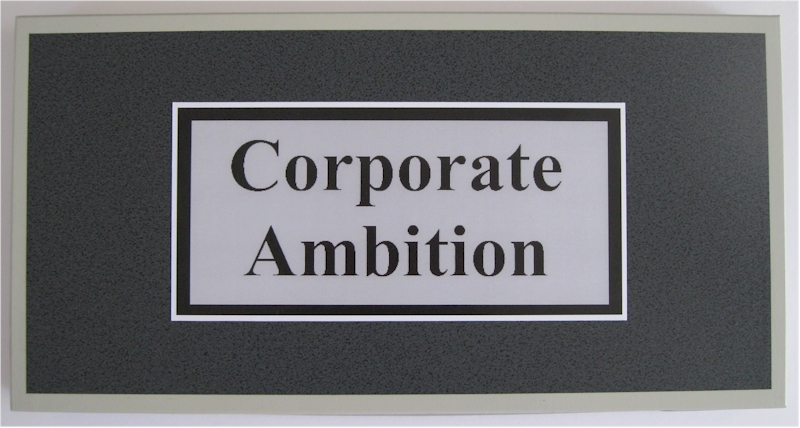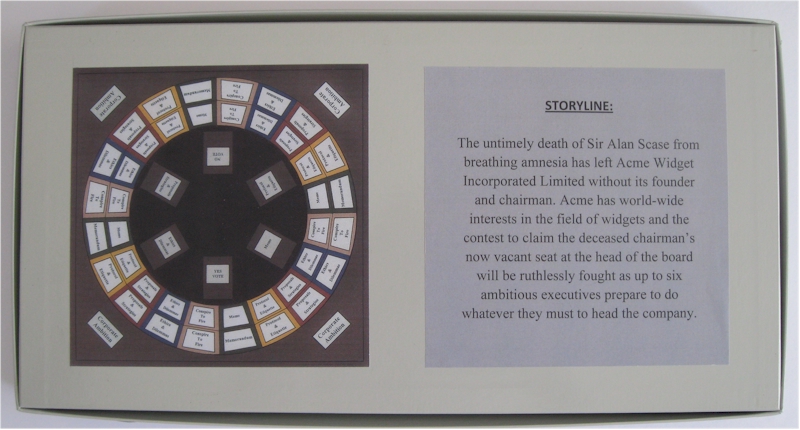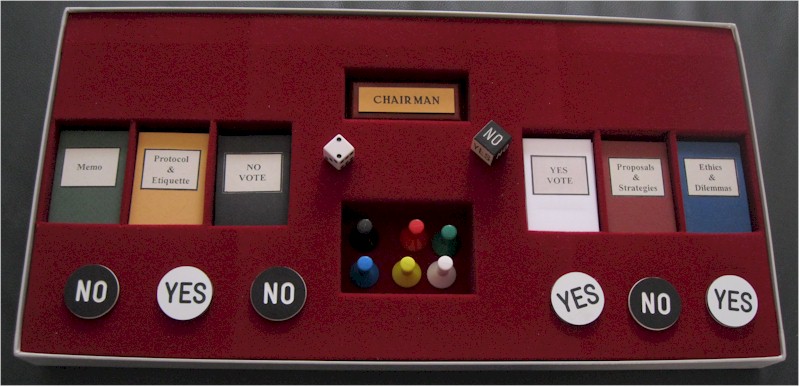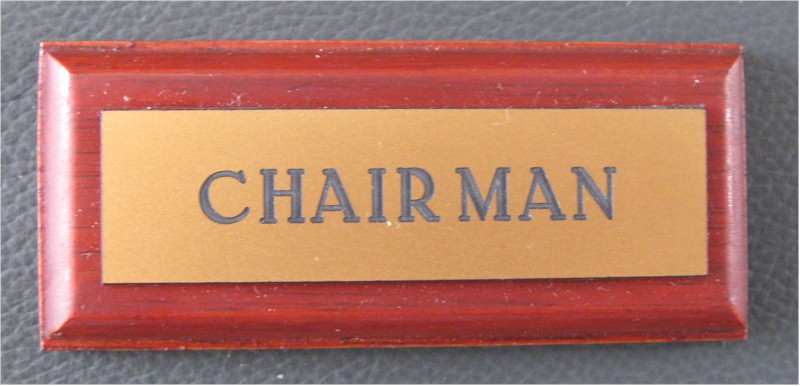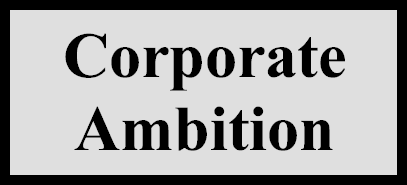
Fight Your Way To The Top
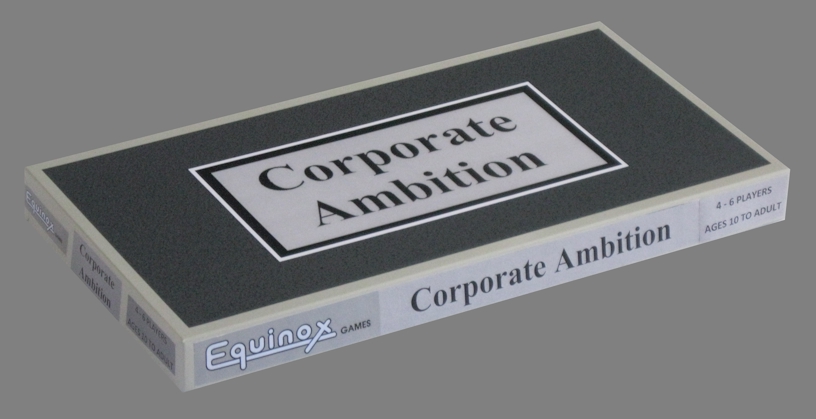
CONCEPT:
A board game for four to six players CORPORATE
AMBITION™ is a game of self serving conspiracy and the quest for power
in the ruthless world of big business. The objective is to win the
‘CHAIRMAN’ nameplate trophy by climbing the corporate ladder (defined
on the playing board as advancing from the outer circle to the inner
circle and then to the position of chairman) faster than your opponents
while not getting demoted or fired. Each player assumes the role of a
Divisional Manager and Director of the company and is competing against
other Directors to become the Chairman of the board. The board design
features two circles of playing spaces representative of two levels on
the corporate ladder, which are the outer circle and the inner circle.
Players begin travelling around the outer circle responding to the
playing spaces and collecting votes, eventually advancing to the inner
circle and on to win the ‘CHAIRMAN’ nameplate trophy.
STORYLINE:
The untimely death of Sir Alan Scase from breathing amnesia has left
Acme Widget Incorporated Limited without its founder and chairman. Acme
has world-wide interests in the field of widgets and the contest to
claim the deceased chairman’s now vacant seat at the head of the board
will be ruthlessly fought as up to six ambitious executives prepare to
do whatever they must to head the company.
The executive contenders are as follows:
Sophie Jones
(Red Pawn)
Attractive, promiscuous and ambitious she will sleep her way to the top if she has to.
Julian Jamison
(Green Pawn)
The snappily dressed smart fart yuppie. Cocky and confident, but has he really got what it takes?
Primrose Peacock
(White Pawn)
A relentless piranha who’s father has some influential business connections.
Benjamin Goldberg
(Yellow Pawn)
Clever with financial dealings. He simply believes he is the chosen one.
Steve Gates
(Blue Pawn)
The techno whiz with a computer brain that wants to rule the world.
Madeline Greer
(Black Pawn)
A political feminist determined to crack the glass ceiling
DESCRIPTION OF PLAYING PARTS: -
1 Playing board:

The playing board has forty stepping spaces - twenty around the outer and twenty around the inner circle.
The 40 playing spaces are split into five different types:
MEMORANDUM
PROTOCOL and ETIQUETTE
PROPOSALS and STRATEGIES
ETHICS and DILEMMAS
CONSPIRE TO FIRE
Centrally placed on the board are six card stack positions for:
YES VOTE cards.
NO VOTE cards.
MEMO cards.
PROTOCOL and ETIQUETTE cards.
PROPOSALS and STRATEGIES cards.
ETHICS and DILEMMAS cards.
2 One normal 6 sided dice.
3 One YES/NO dice (three sides YES & three sides NO).
4 Six YES/NO voting discs (One side YES & one side NO).
|
 |
5 Six playing (executive) pawns of different colours.
6 Playing cards: - There are three hundred and sixty playing cards of six different types, these being: -
Sixty YES VOTE (white) cards.
Sixty NO VOTE (black) cards.
Sixty MEMO (green) cards.
Sixty PROTOCOL and ETIQUETTE (yellow) cards.
Sixty PROPOSALS and STRATEGIES (red) cards.
Sixty ETHICS and DILEMMAS (blue) cards.
7 One ‘CHAIRMAN’ nameplate trophy.
8 Rulebook.
Winning enough votes of approval for agreeable proposals and
strategies, understanding correct etiquette and protocol and handling
dilemmas and ethical matters successfully will help each player rise up
the corporate ladder whilst collecting memos of information that could
help destroy the careers of his or her rivals.
THE PLAYING CARDS.
YES VOTE
and NO VOTE cards. These contain vote values ranging from ten (10) to one hundred (100) votes and are representative of shareholders.
MEMORANDUM
cards contain gossip and information about various executives with the potential to have them demoted or fired.
PROTOCOL & ETIQUETTE (Cards themselves self-explanatory)
The cards allude to correct manners and correct behaviour opposed to
what would be considered a business persons bad manners or bad behaviour in the
business world. The cards are used in conjunction with a 1-6 dice.
In
receiving one of these cards the card holder will read it aloud.It asks
two questions along with requesting a decision from all the other
players except the the cardholder who can only break a deaklock
depending on how many people are playing the game.
The first (specific) question only asks "Who? Did this or that"?
The second question (common on all of the P&E cards) asks:-
Will?
Get "X" number NO VOTE/S as a penalty and for players to respond using
their YES/NO disc tablets to decide. A "YES" majority means a penalty.
Apart from the specific first question all sixty cards have basically the same remaining information printed on them.
The
only other difference will be that some will have either the numbers 1,
2 or 3 in inverted commas on them which represents the seriousness of
the penalty for bad behaviour.
Each card displays the penalty as either, "1", "2" or "3" NO VOTE card/s
Of the sixty P&E cards there are 25 with "1", 20 with "2" and 15 with "3" on them
Each card also has the numbers 1 to 6 matched to a particular pawn color.
The last sentence on the card says:- Now throw the dice and find out.
(The dice does not get thrown before the penalty decission. Only after.)
PROPOSALS & STRATEGIES (cards themselves self-explanatory)
Some of these cards suggest a business proposal to vote on. Others will
suggest a strategy or offer one to back stab or have someone else do
your dirty work for you. Some others will give a simple instruciton. In
responding to this type of card players will generally use the YES/NO
dice at other times they 1-6 dice and sometimes no dice.
At times if not playing with an even amount of players a card holder
not initially be involved in a vote may need to break a dead lock by
throwing the appropriate dice.
 |
 |
|
ETHICS and DILEMMAS cards contain a dilemma or
an ethical question and in responding to this type of card each player
use their YES/NO disc tablet (Yes on one side and No on the other).
Each player responds to the question on the card with their answer on
the tablet face up and covered until everyone is ready and they reveal
their discs together. If the cardholders response is with the majority,
then that player picks up a YES vote card, if with the minority, a NO
vote card. If evenly split, the cardholder decides with the YES/NO dice.
 |
 |
|
USE OF PLAYING CARDS AND SPACES: -
YES VOTE and NO VOTE cards. Players are
required to get a predetermined number of YES votes over NO votes to
advance in the game, first from the outercircle to the inner circle and
then enough to win the ‘CHAIRMAN’ nameplate trophy.
YES VOTE and NO VOTE cards are picked up when having either won or lost
a vote. Players keep vote cards they receive and try to accumulate a
number (???? yet to be decided) of YES VOTES over NO VOTES to advance
from the outer to the inner circle on the board. Upon reaching the
inner circle a player separates their YES and NO cards and returns them
to the bottom of their respective card stacks on the board.
Having reached the inner circle a player then begins the same procedure
again to be the first to accumulate enough of a YES vote advantage to
win the ‘CHAIRMAN’ nameplate trophy.
Note: - Vote cards will also be shuffled and returned to their card stacks when: -
(a) A player is demoted (yes votes only)
(b) A player is fired (all yes and no votes)
MEMORANDUM cards are received and collected one at a time. Firstly when
starting the game and later when landing on the Memorandum playing
space. Memo cards may also be collected or given when responding to a
Conspire to Fire playing space. A memo card will contain damaging
information about a particular player or: - (if a wildcard substitute
damaging information about any player).
Three out of a set of four “demoted/demotion” or five out of a set of
five “fired”must be collected to have a player either demoted or fired
from the game. There are nine Memorandum cards about each player (four
demotion and five fired) and a further six Memorandum wildcards about
any player (all fired)
Note: - sets of "demoted/demotion" cards refer to a particular player
and an opposing player must collect at least three of these to get that
other player demoted.
A set of “fired” cards can refer to a particular player but wildcards
can substitute as to help an opposing player collect the five required
to get that other player fired.
Four of each type “demoted/demotion” and five of each type “fired”
equalling nine per player times six = 54 + 6 “fired” wildcard
substitutes = 60 “MEMO” cards. Three matching “demotion” or five
matching (or including substitutes) “fired” memo cards are required to
have a player demoted or fired.
If on the outer circle, “demoted”or “demotion” means the loss of all of that players YES vote cards.
If on the inner circle, “demoted”or “demotion” means returning to the outer circle, but no loss of YES vote cards.
A “fired” memo has the potential to have a player fired from the game.
Memo to: -?
About: -?
Security cameras have recorded evidence of a CEO attempting to sabotage
the honest efforts of other board members. This evidence has the
potential to get him/her “FIRED” (This card is a wildcard substitute)
The CONSPIRE TO FIRE playing space works in conjunction with the Memo
cards collected and held between the players. When a player lands on
this space s/he can conspire with any other player to either give or
receive a matching (if held) Memo card with information about a third
player (one card and one chosen player per turn). The player who lands
on the Conspire To Fire playing space chooses another player and hands
that person one of his/her memo cards unsighted by anyone else whilst
asking “can you help me with one of these?” The other player may
respond by saying “Yes I can” or “No I can’t” or “Yes, but I have more
than one so perhaps you’d like to give it to me.” Eventually one of
these conspiring players may hold a set of matching cards against a
third player and have them demoted or fired out of the game.
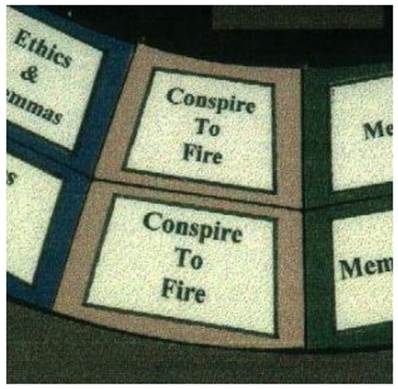
Note: - Whoever can hold the most of the damaging memo card when
conspiring is best for both players involved as both will benefit
equally from the demotion or firing of a mutual rival.
PROTOCOL
& ETIQUETTE cards are picked up one at a time when landing on a
Protocol & Etiquette playing space. Players read them out aloud and
respond to them. Once used card is then returned to the bottom of the
respective card stack.
PROPOSALS
& STRATEGIES cards are picked up one at a time when landing on a
Proposals & Strategies playing space. Players read them out aloud and respond to them. Once used card is then retunred to the bottom of the respective card stack.
ETHICS & DILEMMAS cards are picked up one at a time when landing on
an Ethics & Dilemmas playing space. The card contains a dilemma or
an ethical problem that the player will read to his/her fellow
boardroom executives who will each respond using their YES/NO disc
tablet. Players decide their response and place the disc on the table
under their hands with their YES or NO vote response face up. When all
players are ready they reveal their responses together. If the majority
agree with the cardholders disc, the cardholder picks up a YES vote
card. If the majority disagree a NO vote card is picked up. If a
stalemate, the cardholder throws the YES/NO dice to decide.
Note: - Protocol and Etiquette / Proposals and Strategies / Ethics and
Dilemmas These cards are returned to the bottom of their respective
card stacks immediately after use. Memo cards are gathered and held
until the correct amount are used to demote or fire an opponent. They
are then returned to the bottom of their respective card stack. Yes
Vote / No Vote cards are collected and held until advancing to a higher
level on the board. Then they are shuffled and returned to the bottom
of their respective card stacks. They (both yes and no votes) are also
returned by a player being fired out of the game and (yes votes only)
by a player being demoted. In the event that either Yes or No vote card
stacks get low in the centre of the board play can be suspended while
each player subracts his/her cards from each other as to replenish the
board stack/s e.g. If having 160 YES and 80 NO you just keep 80 YES
credits and put the rest back under their respective card stacks. The
same applies if in reverse and you would be in the black and just
keeping the NO card debits.
TO PLAY:
The chairman nameplate trophy is placed in the centre of the board. All
playing card types are separately shuffled and placed in their
individual card stack positions.
Each player receives a YES/NO disc and a playing pawn (the colour of
which determines the character that player is) and places it on any
MEMORANDUM playing space on the outer circle with play to move
clockwise.
TO START:
Each player picks up a MEMO card and then throws the 1 to 6 dice to determine whom starts.
Play begins and continues in either direction ( but only one way for
each turn) around the outer circle with players responding to the
playing spaces and picking up cards. Once reaching the inner circle
players can again travel in either direction on subsequent turns.
Note:- A good strategy giving a higher chance of picking up a Memo or
to land on a Conspire to Fire space is to have two chances within the
six possible spaces thrown with the dice by travelling the most
possible way (clockwise or anti-clockwise) Depending on what space you
start on there will be two chances in six either way of landing on the
same type of space.
Once having collected the required number of YES over NO votes.
A player then shuffles and returns his/her accumulated YES and NO vote cards to their respective card stacks on the board.
S/he then moves his/her playing pawn directly into the same type of
inner playing space type that it was on when in the outer circle.
Having reached the inner circle, the player now repeats the same
procedure to become the new chairman of Acme Widget Incorporated
Limited and the holder of the ‘CHAIRMAN’ nameplate trophy.
